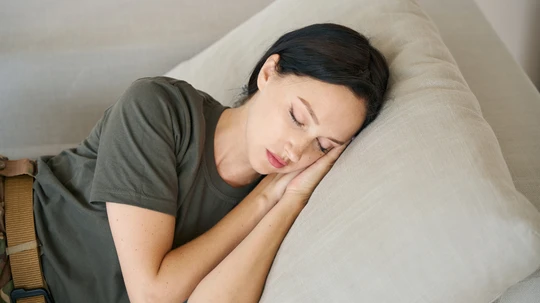The “Military Sleep Method” is a short, structured relaxation routine designed to help people fall asleep quickly by combining progressive muscle relaxation, controlled breathing, and guided imagery.
It was popularised in books and traditional media as a technique taught to military pilots and soldiers so they could sleep in noisy, stressful environments; the routine traces back to relaxation training described in older performance-training materials and was widely shared after being featured in popular writing about military sleep hacks.
Here’s how it works: the method’s base is teaching the nervous system to shift from arousal to rest. You intentionally relax facial muscles, drop shoulders and arms, exhale while relaxing the chest, then relax the lower body, finishing with a brief mental exercise that clears the mind (visualizing a calm scene or repeating ‘don’t think’). These steps combine progressive muscle relaxation and visualisation to lower heart rate and reduce sympathetic (fight/flight) activity.
Step-by-step guide to military sleep:
- Lie down comfortably and close your eyes.
- Relax your face, unclench jaw, soften tongue, ease forehead.
- Drop your shoulders and let arms fall loose at your sides. Relax hands and fingers.
- Breathe out, relax your chest, then your legs, upper to lower.
- Clear your mind for 10 seconds: Imagine a peaceful scene (floating in a canoe, lying in a black room) or repeat ‘don’t think.’ If intrusive thoughts appear, return to the visualisation. Practicing daily helps build automaticity.
Evidence & other experiences: While there’s no rigorous randomised trial of the exact ‘military method’ sequence, its building blocks; progressive muscle relaxation, paced breathing, and guided imagery, have shown measurable benefits for relaxation and sleep onset in multiple studies. Progressive muscle relaxation and guided imagery reliably increase relaxation versus controls. However, claims of reliably falling asleep in two minutes are anecdotal and likely optimistic for most people; mastering the routine can take weeks. If you have chronic insomnia, sleep apnea, or mood disorders, consult a clinician, behavioural sleep therapy (CBT-I) may be more appropriate.
Tips to get the most from the method:
Practice the routine at the same time nightly for 4-6 weeks to build the reflex.
Combine with good sleep hygiene, cool, dark room; limited screens; consistent schedule.
Be patient: use it as a relaxation skill even when you’re not desperate, it strengthens effectiveness.
